On Sept. 13, two B-2A Spirit stealth bombers out of Whiteman Air Force Base, Missouri, flew a round-robin mission across the Atlantic.
What someone saw as a rehearsal of an eventual air strike on Syria, was (more or less) a standard mission aimed at testing the U.S. capability to launch “Global Strike” missions across the globe from CONUS (Continental US).
As happened during the North Korea crisis, when a B-2 reached South Korea amid threat of a ballistic missile launch by Pyongyang, or during the war in Libya, when two Spirit bombers performed a real bombing run on Gaddafi’s airports taking off from their base in Missouri.
But, whereas the attack on Libya had been really “stealth” (since the bombers used a REACH callsign, usually allocated to tanker, transport and support aircraft to go unnoticed among airband listeners) the entire flight of the two B-2s across the Pond on Sept. 13 was not only announced by the deployment of an E-6 Mercury in Europe, but was also very well documented by North American and British milair monitors.
Among them, “Rich”, an expert in the field, who has logged the entire 20-hour mission and has provided The Aviationist the following detailed log.
Two B-2A Spirits, callsign HAMAL 11/12 took off in the early hours of September 13 and conducted a global power mission over the north Atlantic.
They refuelled over Nova Scotia at 0800z with two KC135s callsign ETHYL B1/B2.
After an hour of refuelling they routed overhead Newfoundland before heading east across the Atlantic ocean.
Two KC-135s from Fairchild McConnell AFB, callsign SPUR 57/58 forward deployed to RAF Mildenhall a few days previously and were tasked to conduct the Bombers second Air Refuelling which took place around 44N22W around 1230z, a few hundred miles west of Spain.
After the second air refuelling, the bombers headed south down the Portuguese FIR before routing back west towards Newfoundland for their third air refuelling over Nova Scotia with two more KC-135s, ETHYL B3/B4. The B-2As then transited back to Whiteman AFB.
As well as the six KC-135s to refuel the bombers, the B-2s were also supported by a forward deployed E-6B Mercury which was TDY (Temporary Deployed) at Stuttgart.
Using callsign RAZZ02 with the ATC (Air Traffic Control) the E-6 acted as SKYMASTER for the bombers using the callsign of AUDIO KIT throughout the second half of the mission. The E-6B set up an orbit in the western half of the Bay of Biscay.
This time the mission was monitored from the beginning to the end. If it were a real combat sortie, very few details would have been broadcast for anybody to hear. Hopefully…..
Image credit: Christoper A. Ebdon

















